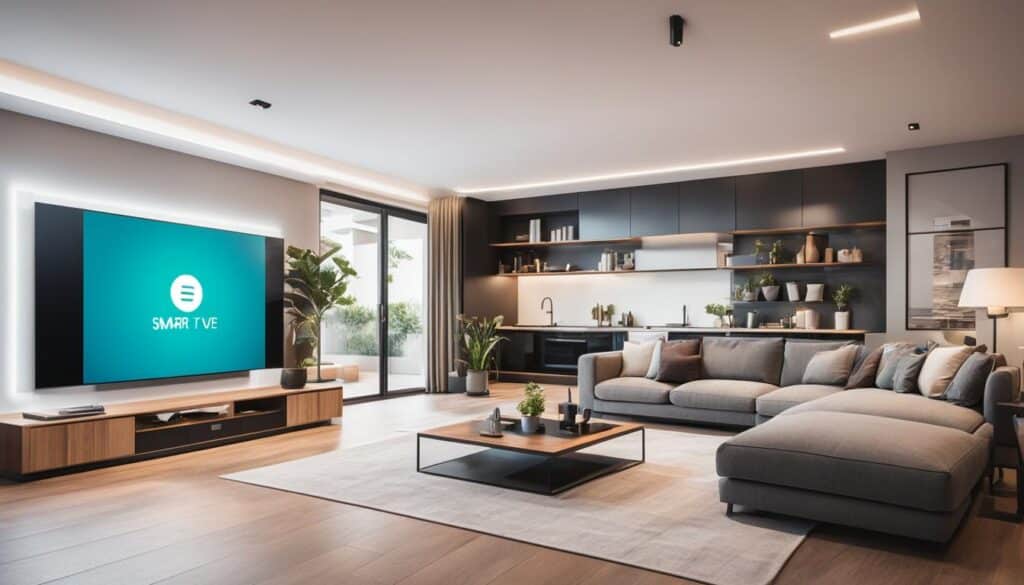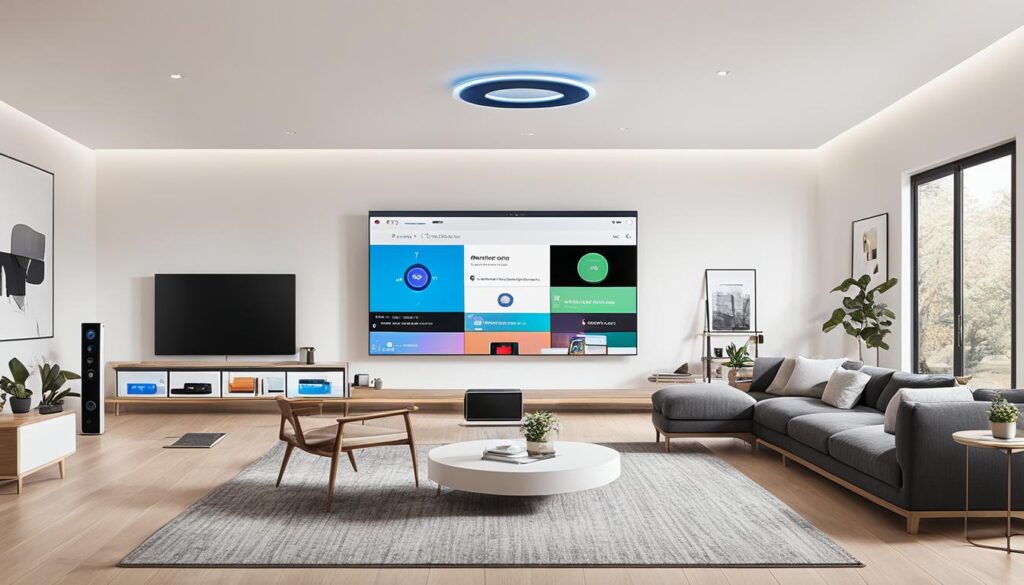Welcome to the exciting world of smart homes, where technology seamlessly integrates with your living space to enhance convenience and efficiency. As a newcomer, understanding the basics of smart home connectivity is essential to make informed decisions about transforming your home. In this article, I’ll guide you through the fundamentals, so you can confidently embrace the world of smart home technology.
Table of Contents
Key Takeaways:
- Smart home connectivity allows devices and systems within your home to communicate and interact with each other.
- Wireless protocols like Wi-Fi, Bluetooth, Zigbee, and Z-Wave enable smart home connectivity.
- Common devices in a smart home include lighting systems, thermostats, security cameras, door locks, and entertainment systems.
- Smart home connectivity platforms such as Google Home, Amazon Alexa, and Apple HomeKit act as central hubs for controlling multiple devices.
- Consider compatibility, security, and scalability when setting up a smart home network.
What is Smart Home Connectivity?
Smart home connectivity revolutionizes the way devices and systems interact within your home. With the help of wireless protocols such as Wi-Fi, Bluetooth, Zigbee, and Z-Wave, these devices can communicate seamlessly, creating a connected ecosystem. Through this connectivity, homeowners gain the ability to control and automate various functions, such as lighting, security, heating, and entertainment, using a central hub or a smartphone app.
Smart home connectivity brings numerous benefits to homeowners. First and foremost, it provides convenience. Imagine being able to turn off all the lights in your house with a single command or adjusting the temperature of your home while you’re still at work. These abilities streamline everyday processes and simplify your daily routine.
Moreover, smart home connectivity brings energy efficiency to your fingertips. By integrating smart lighting systems and thermostats, you can optimize energy consumption, reducing your environmental footprint and potentially lowering your energy bills.
In addition, smart home connectivity enhances security. With the ability to remotely monitor and control your security cameras, door locks, and alarm systems, you can have peace of mind wherever you are. You can receive instant notifications and take immediate action in case of any suspicious activities, ensuring the safety of your home and loved ones.
Overall, smart home connectivity empowers homeowners to create a more efficient, comfortable, and secure living environment. By seamlessly connecting various devices and systems, you can transform your house into a smart home that caters to your needs and lifestyle.
Types of Smart Home Connectivity Protocols
In order for devices in a smart home to communicate and interact with each other, various connectivity protocols are used. Understanding these protocols is essential when selecting the right devices and ensuring compatibility within the smart home network.
Here are some of the most common smart home connectivity protocols:
- Wi-Fi: This is the most widely used protocol in smart homes. It provides a high-speed and reliable connection for devices, allowing them to connect to the internet and communicate with each other seamlessly.
- Bluetooth: Bluetooth is commonly used for short-range communication between devices, typically within a range of 30 feet. It is often used for connecting smartphones, speakers, and wearable devices.
- Zigbee: Zigbee is a mesh networking protocol that enables devices to create a network and communicate with each other over longer distances. It is commonly used for controlling lighting systems, sensors, and other smart home devices.
- Z-Wave: Similar to Zigbee, Z-Wave is another mesh networking protocol that allows devices to form a network and communicate with each other. It is often used for home security systems, thermostats, and door locks.
Each protocol has its own advantages and considerations. Wi-Fi offers a high-speed connection but consumes more power, while Bluetooth is ideal for short-range communication. Zigbee and Z-Wave are great for creating robust networks, but may require a separate hub for compatibility. Homeowners should choose the protocol that best suits their needs and the devices they plan to connect.
| Protocol | Advantages | Considerations |
|---|---|---|
| Wi-Fi | High-speed and reliable connection | Higher power consumption |
| Bluetooth | Ideal for short-range communication | Limited range |
| Zigbee | Creates a robust network over longer distances | May require a separate hub |
| Z-Wave | Mesh networking for home security systems and door locks | May require a separate hub |
Choosing the right connectivity protocol is crucial for a successful smart home setup. It ensures that devices can communicate seamlessly and work together to enhance the overall smart home experience.
Devices that Can Be Connected in a Smart Home
In a smart home, a wide range of devices can be connected, offering homeowners increased convenience and control over their living spaces. The ability to connect and interact with these devices remotely enhances energy efficiency, security, and overall living experience.
Here are some common examples of devices that can be integrated into a smart home setup:
- Smart lighting systems: Control and customize the lighting in your home through smart bulbs, switches, or dimmers.
- Thermostats: Adjust and automate the temperature settings for optimal comfort and energy savings.
- Security cameras: Monitor and secure your home with smart cameras that provide live streams and motion detection.
- Door locks: Lock and unlock your doors using smart locks, granting access to authorized individuals remotely.
- Smart speakers: Enjoy hands-free control and voice-activated assistance with devices like Amazon Echo or Google Home.
- Entertainment systems: Connect your TVs, audio systems, and streaming devices to create a seamless multimedia experience.
Additionally, appliances such as refrigerators, washing machines, and ovens can also be integrated into a smart home, allowing for greater convenience and automation in daily tasks.
By connecting and controlling these devices, homeowners can create personalized and efficient living spaces that cater to their unique needs and preferences.
Take a look at the image below to see some examples of devices that can be connected in a smart home:

Enhancing Convenience and Efficiency
Connecting devices in a smart home offers numerous benefits. For example, you can create schedules and automations to turn on the lights when you arrive home, adjust the thermostat based on your preferences and occupancy, or receive notifications when unexpected activity is detected by your security cameras.
By seamlessly integrating these devices, smart homes provide an intuitive and efficient way to manage and control various aspects of your living space, enhancing convenience and streamlining daily routines.
Whether it’s turning off the lights from your bed, checking who’s at the door from your smartphone, or adjusting the temperature while away, smart home connectivity empowers homeowners to have greater control over their environment with just a few taps or even voice commands.
Smart Home Connectivity Platforms
To manage and control the various connected devices in a smart home, homeowners can utilize smart home connectivity platforms. These platforms act as a central hub or control center, allowing users to monitor and control multiple devices from a single interface. Examples of popular smart home connectivity platforms include Google Home, Amazon Alexa, and Apple HomeKit.
These platforms often support voice control and can be accessed through smartphones or dedicated smart home hubs.
Quote:
I love how easy it is to control my smart home devices using the Google Home platform. With just a few voice commands, I can adjust the temperature, turn on the lights, and even play my favorite music. It’s like having a personal assistant at my fingertips!

Control Your Home with Ease
Smart home connectivity platforms provide homeowners with a convenient and intuitive way to manage their connected devices. Whether you prefer to use voice commands or navigate through a smartphone app, these platforms make it seamless to control various aspects of your home.
With Google Home, you can simply say “Hey Google, turn off the lights” and watch as the connected smart bulbs instantly respond. Amazon Alexa offers similar capabilities, allowing you to control devices through voice commands using the “Alexa” wake word. Apple HomeKit provides a seamless ecosystem for Apple users, allowing control of compatible devices through the Home app or Siri voice commands.
Enjoy Seamless Integration
One of the advantages of using smart home connectivity platforms is the ability to integrate different brands and devices into a cohesive system. These platforms often support a wide range of devices, from lights and thermostats to security cameras and door locks.
- Google Home: Works with popular brands like Philips Hue, Nest, and Ring.
- Amazon Alexa: Compatible with a variety of devices including ecobee, August, and TP-Link.
- Apple HomeKit: Supports devices from Apple’s HomeKit ecosystem, such as Eve, Honeywell, and Netatmo.
This seamless integration allows homeowners to control and automate their entire smart home setup from a single platform, eliminating the need for multiple apps or hubs.
Considerations for Smart Home Connectivity
Before diving into smart home connectivity, there are several considerations that newcomers should keep in mind. First, compatibility is crucial. Homeowners should ensure that the devices they plan to connect are compatible with their chosen connectivity protocol or platform. This ensures seamless integration and functionality across all connected devices.
Security is another important consideration when setting up a smart home. With the increasing prevalence of connected devices, there is also a higher risk of potential hacking or unauthorized access. It’s essential to choose reputable devices from trusted brands and follow best practices for securing the network. Consider using strong passwords, enabling encryption, and regularly updating firmware to minimize security vulnerabilities.
Scalability is also worth considering in smart home setups. As technology continues to evolve, homeowners may want to add more connected devices or expand their smart home systems in the future. It’s important to plan ahead and ensure that the chosen connectivity protocol or platform can accommodate future growth and integration with additional devices or systems.
“Compatibility, security, and scalability are crucial considerations for a successful smart home setup.”
By carefully considering these factors, newcomers can lay a solid foundation for their smart home connectivity journey. Ensuring compatibility, prioritizing security, and planning for scalability allows for a reliable and future-proof smart home system that offers convenience, energy efficiency, and enhanced living experiences.
| Considerations | Description |
|---|---|
| Compatibility | Ensure devices are compatible with the chosen connectivity protocol or platform |
| Security | Choose reputable devices, follow best practices for securing the network |
| Scalability | Plan for future expansion and accommodate additional devices or systems |
Setting Up a Smart Home Network
Setting up a smart home network is an exciting endeavor that requires careful planning and execution. By following a few key steps, homeowners can transform their living spaces into efficient and interconnected smart homes. Let’s explore the essential components and considerations involved in setting up a smart home network.
Determining the Connectivity Protocol
The first step in setting up a smart home network is to determine the connectivity protocol that best suits your needs. Consider the devices you plan to connect and their compatibility with different protocols. Some popular options include Wi-Fi, Bluetooth, Zigbee, and Z-Wave. Each protocol has its advantages and considerations, so choose the one that aligns with your requirements.
Selecting a Compatible Smart Home Platform
Once you’ve decided on a connectivity protocol, the next step is to select a compatible smart home platform. The platform serves as a central hub that allows you to control and manage all your connected devices from a single interface. Popular platforms include Google Home, Amazon Alexa, and Apple HomeKit. Choose a platform based on its features, integration capabilities, and ease of use.
Adding Devices to the Network
Adding devices to your smart home network is straightforward and can be done in a few different ways. Some devices may require you to follow the manufacturer’s instructions, while others can be added through the setup process of your chosen smart home platform. Make sure to follow the guidelines provided and ensure that each device is successfully connected to the network.
Configuring and Securing the Network
Configuring and securing your smart home network is crucial to protect your privacy and ensure the proper functioning of your devices. Set up strong passwords for your network and enable encryption to safeguard against unauthorized access. Regularly check for updates and patches to keep your network and devices up to date with the latest security features.
To better visualize the steps involved in setting up a smart home network, refer to the table below:
By following these steps and considering the compatibility, security, and scalability aspects, homeowners can successfully set up a smart home network that meets their needs. With a fully connected home, you’ll enjoy the convenience and efficiency that smart home technology offers.
Conclusion
Smart home connectivity revolutionizes the way we interact with our living spaces, bringing convenience, efficiency, and security to our fingertips. By grasping the basics of connectivity, homeowners can confidently navigate the world of smart home technology and optimize their choices for devices, protocols, and platforms.
When setting up a smart home network, compatibility is key. Ensuring that devices align with the chosen connectivity protocol or platform guarantees seamless integration and hassle-free control. Moreover, prioritizing security measures by selecting reputable devices and following best practices safeguards against potential vulnerabilities.
As homeowners embark on their smart home journey, scalability cannot be overlooked. Considering future expansion ensures that their smart home setup remains flexible to accommodate additional devices and evolving needs.
With the right knowledge and planning, newcomers can unlock the full potential of smart home connectivity, transforming their living spaces into personalized, efficient, and secure environments that enhance their everyday experiences.
FAQ
What is smart home connectivity?
Smart home connectivity refers to the ability of devices and systems within a home to communicate and interact with each other through wireless protocols such as Wi-Fi, Bluetooth, Zigbee, or Z-Wave. This allows homeowners to control and automate various functions in their living spaces using a central hub or smartphone app.
What types of smart home connectivity protocols are commonly used?
There are several types of connectivity protocols commonly used in smart homes. The most familiar and widely used protocol is Wi-Fi, offering a high-speed and reliable connection for devices. Bluetooth is another common protocol for short-range communication. Zigbee and Z-Wave are mesh networking protocols that allow devices to create a network and communicate with each other over longer distances.
What types of devices can be connected in a smart home?
The range of devices that can be connected in a smart home is extensive. Some common examples include smart lighting systems, thermostats, security cameras, door locks, smart speakers, and entertainment systems. Additionally, appliances such as refrigerators, washing machines, and ovens can also be integrated into a smart home setup.
What are smart home connectivity platforms?
Smart home connectivity platforms act as a central hub or control center, allowing users to monitor and control multiple devices from a single interface. Examples of popular smart home connectivity platforms are Google Home, Amazon Alexa, and Apple HomeKit. These platforms often support voice control and can be accessed through smartphones or dedicated smart home hubs.
What considerations should be kept in mind for smart home connectivity?
Before diving into smart home connectivity, several considerations should be kept in mind. Compatibility is crucial, ensuring that the devices to be connected are compatible with the chosen connectivity protocol or platform. Security is important, and homeowners should choose reputable devices and follow best practices for securing the network. Scalability should also be considered, planning for future expansion and ensuring that the smart home setup can accommodate additional devices or systems.
How do I set up a smart home network?
Setting up a smart home network involves several steps. First, homeowners should determine the connectivity protocol they want to use based on their needs and the devices they plan to connect. Next, they need to select a compatible smart home platform to act as a central hub for controlling the connected devices. Devices can then be added to the network by following the manufacturer’s instructions or through the smart home platform’s setup process. Finally, homeowners should configure and secure their network by setting up strong passwords and enabling encryption.


